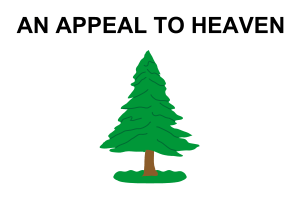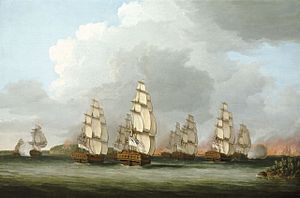Massachusetts Naval Militia facts for kids
Quick facts for kids Massachusetts Naval Militia |
|
|---|---|

|
|
| Active | 1775-1783 1812-1815 1898 |
| Allegiance | Province of Massachusetts Bay United States of America Commonwealth of Massachusetts |
| Role | Naval Forces, Coast Guard |
| Motto(s) | "An Appeal to Heaven" |
| Engagements | American Revolutionary War
War of 1812 Spanish–American War |
| Commanders | |
| Notable commanders |
Jeremiah O'Brien John Foster Williams Jonathan Haraden George Little |
The Massachusetts Naval Militia was a special navy for Massachusetts during the American Revolutionary War. It was first called the Massachusetts Colonial Navy, then the Massachusetts State Navy. It started on December 29, 1775. Its main job was to protect Massachusetts' interests during the war.
This small navy used 25 ships during the war. These ships did many jobs. Some were used as floating prisons. Others carried important messages. Many were combat ships, fighting enemy vessels. One of its most famous battles was the Penobscot Expedition in 1779. In this battle, all of its ships were lost. Even ships from private companies helping them were destroyed.
The Massachusetts Naval Militia was also active in later wars. It served in the War of 1812 and the Spanish–American War. Today, if this historic group were to be restarted, it would be up to the Governor of Massachusetts or the state's lawmakers.
Contents
The American Revolutionary War began in April 1775. British ships, part of the Royal Navy, often attacked towns along the coast of Massachusetts. These attacks caused a lot of damage. To protect their homes and people, leaders in Massachusetts knew they needed their own naval defense.
In June 1775, a group of leaders suggested building at least six armed ships. These ships would have up to fourteen guns each. They would be managed by a special safety committee. The famous Battle of Bunker Hill happened soon after. This delayed the plans for a while.
Later, the town of Machias asked for help. They had captured some British ships. The Massachusetts government decided to officially use two of these captured ships. They named them Machias Liberty and Diligence. Jeremiah O'Brien was made their commander. These two ships served the state until October 1776.
In November 1775, Massachusetts passed a law. This law allowed them to issue "letters of marque." These were special permits for private ships to attack enemy ships. They also set up courts to handle captured enemy ships and their goods. In February 1776, they approved building ten new ships. They set aside £10,000 for this project.
Building the Fleet: 1776 to 1779
The first ships built were the sloop Tyrannicide and the brigantines Rising Empire and Independence. They were ready to sail by June 1776. Soon after, the sloops Republic, Freedom, and Massachusetts were also finished.
While these ships were being built, new rules were made. These rules set pay for sailors and how to share money from captured enemy ships. In October, a "Board of War" was created. This board oversaw all naval activities for the state.
Over the next few years, Massachusetts bought or built more ships. In 1777, the brigantine Hazard was built. In 1779, they bought the brigantine Active. This ship had been captured by Hazard.
The biggest ship in the state navy was authorized in April 1778. This was the Protector. It was a large ship with 28 guns and a crew of 200. It was launched in the fall of 1779. Sadly, after the disaster of the Penobscot Expedition, Protector was the only ship left in the state navy.
More Ships and Privateers
After 1780, the state continued to add ships to its navy. In 1780, the Mars was bought. In 1781, the Defence was purchased. The last two ships built for the state were Tartar and Winthrop. They were finished in 1782 and 1783.
Massachusetts also allowed many private ships to join the fight. These ships were called privateers. They had "letters of marque" which gave them permission to attack British ships. Nearly 1,000 such permits were given out. In 1779, over 180 captured enemy ships were brought to Massachusetts courts. This meant many captured sailors needed prisons. It also made it harder for the state navy to find sailors, as privateers often paid more.
Battles and Challenges
Massachusetts ships usually patrolled nearby waters. But sometimes, they sailed as far as Europe. There, they would capture enemy ships. The state's ships often worked with privateers, the main American navy, and even French ships.
One tough fight happened on November 25, 1776. A British ship, HMS Hope, captured the Massachusetts ship Independence. Even though Independence had more guns and a bigger crew, the British captain used better sailing skills and tactics to win.
On May 5, 1781, two British ships, HMS Roebuck and HMS Medea, captured the Massachusetts ship Protector. The British navy then used Protector as their own ship, renaming her HMS Hussar.
Most battles for the Massachusetts navy were small. They involved only a few ships and not much fighting. The biggest exception was the Penobscot Expedition. This was a huge operation planned by Massachusetts. The British had built a fort on the eastern side of Penobscot Bay. Massachusetts wanted to remove them.
The expedition included three state navy ships, one from New Hampshire, three from the main American navy, and many private ships. They also carried 1,000 soldiers to attack the fort. But the operation was a disaster. The American naval commander, Dudley Saltonstall, argued with the army commander. When a British fleet arrived, the American fleet fell apart. Ships surrendered, ran aground and burned, or were abandoned. This expedition is called the worst American naval defeat before the attack on Pearl Harbor in World War II. The naval commander, Saltonstall, was later fired.
The Massachusetts navy continued to operate until June 4, 1783. On that day, the Winthrop, the last ship owned by the state, was sold.
Important Captains
Here are some of the brave captains who led the Massachusetts Naval Militia:
| Captain | Years of service | Ships |
|---|---|---|
| Jeremiah O'Brien | Machias Liberty, Diligence | |
| John Lambert | ||
| John Fisk | Tyrannicide, Massachusetts | |
| John Foster Williams | Massachusetts, Republic, Hazard, Protector | |
| John Clouston | Freedom | |
| Jonathan Haraden | Tyrannicide | |
| Daniel Souther | ||
| Simeon Samson | Independence, Hazard, and Mars | |
| Richard Welden | ||
| Allen Hallet | Tyrannicide, Republic, Active, Tartar | |
| James Nevens | ||
| John Cathcart | Tyrannicide | |
| George Little | Winthrop |
Here are some of the ships that served in the Massachusetts Naval Militia:
| Ship | Type (guns) | Years of service | Captains |
|---|---|---|---|
| Machias Liberty | sloop (10–20) | 1775–1776 | O'Brien |
| Diligent | schooner (10–20) | 1775–1776 | O'Brien |
| Tyrannicide | brigantine (at first a sloop) (14) | 1776–1779 | Fisk, Haraden, Hallet, Cathcart |
| Rising Empire | brigantine (10–20) | 1776–1777 | |
| Independence | brigantine (14 x 6-pounder guns, 10 x 4-pounder guns, 10 swivel guns, + 2 x coehorns) | 1776 | Simeon Sampson, or Samson |
| Republic | sloop (10–20) | 1776–1777 | Williams, Hallet |
| Freedom | brigantine (12) | 1776–1777 | John Clouston |
| Massachusetts | brigantine (10–20) | 1776–1778 | Williams |
| Hazard | brigantine (10–20) | 1777–1779 | Williams |
| Active | brigantine (10–20) | 1779 | Hallet |
| Lincoln | galley | 1779–1781 | |
| Protector | frigate (26) | 1779–1781 | Williams |
| Mars | ship (10–20) | 1780–1781 | |
| Defence | sloop (10–20) | 1781 | |
| Tartar | ship (10–20) | 1782–1783 | Hallet |
| Winthrop | sloop (10–20) | 1782–1783 | Little |



